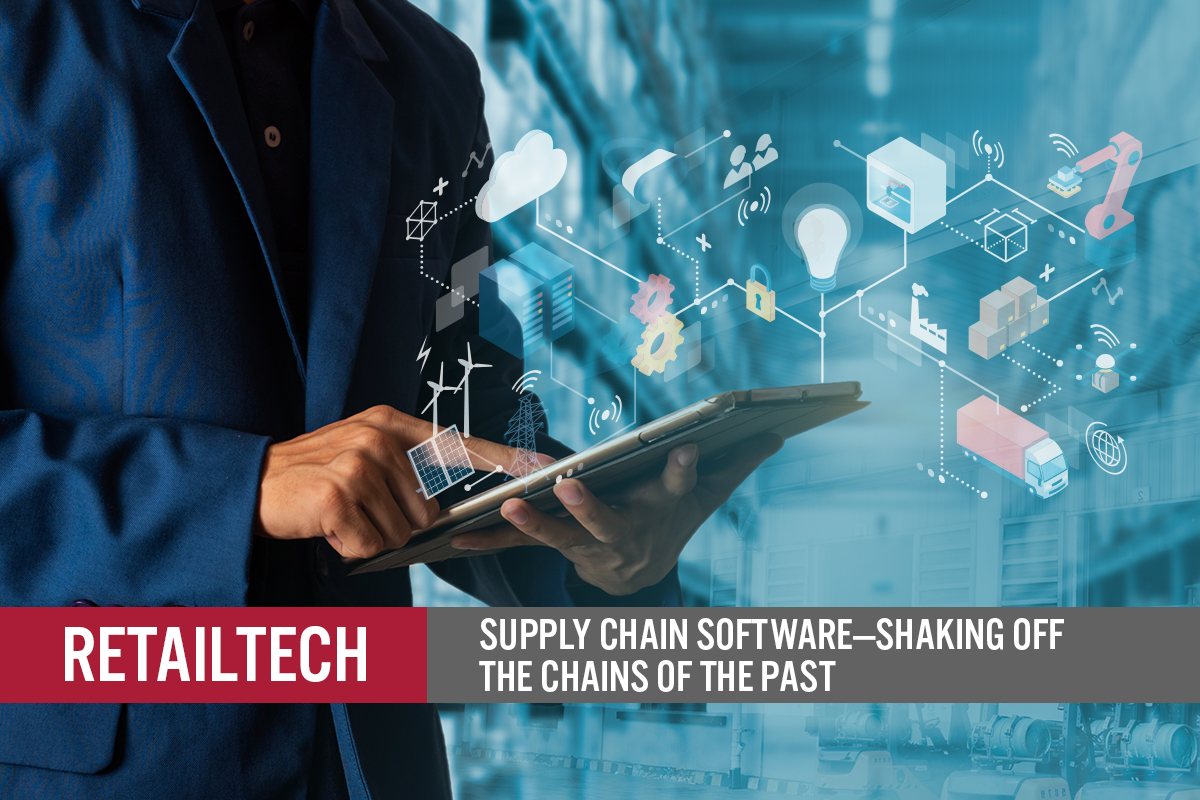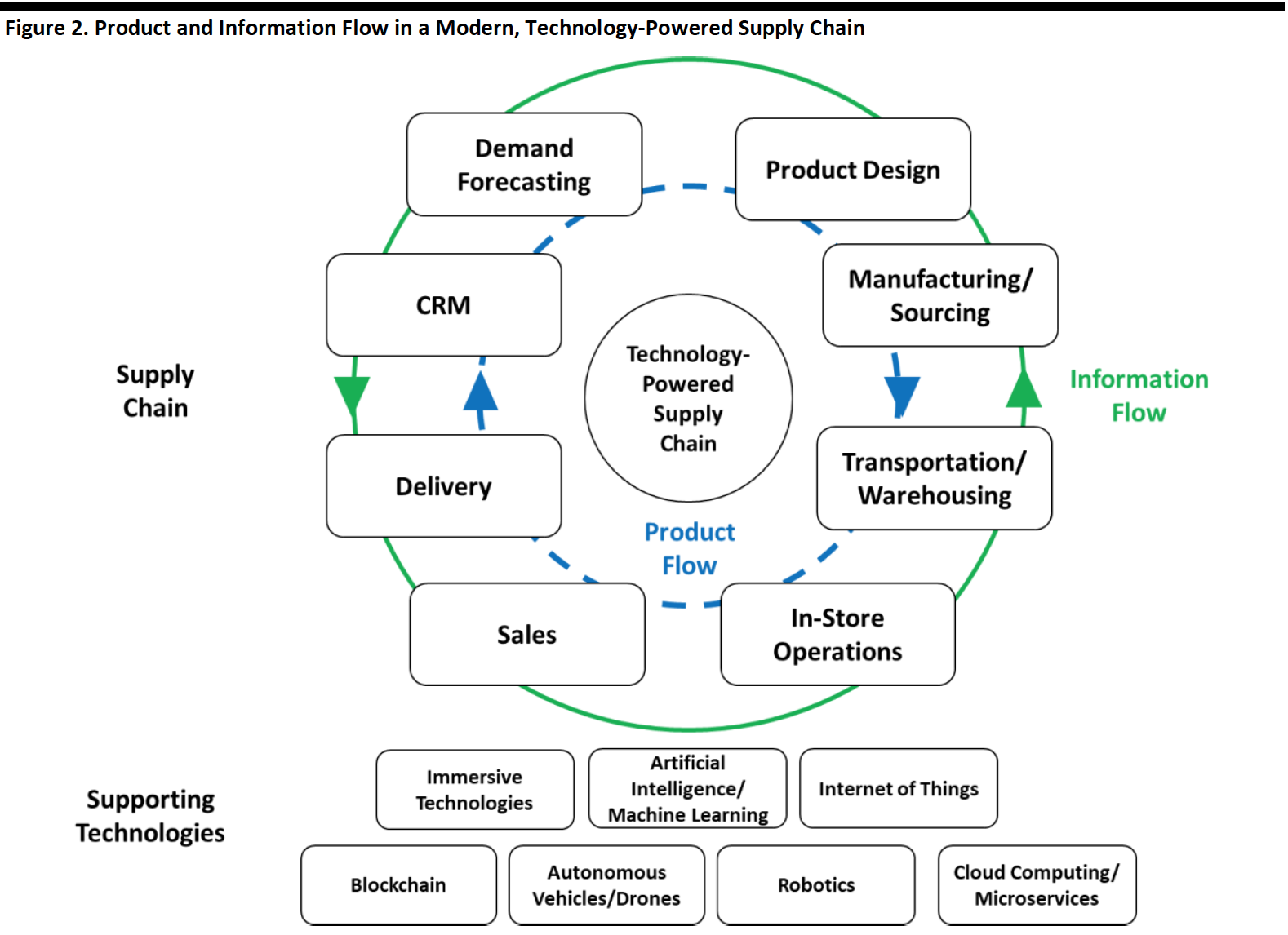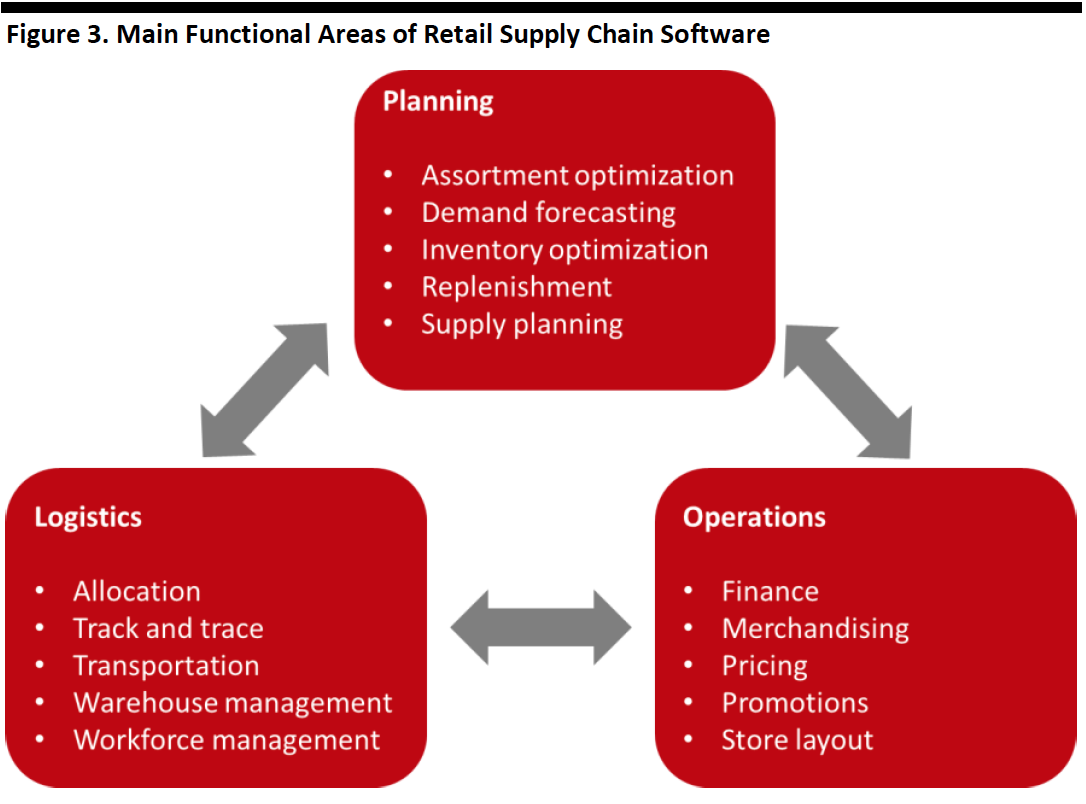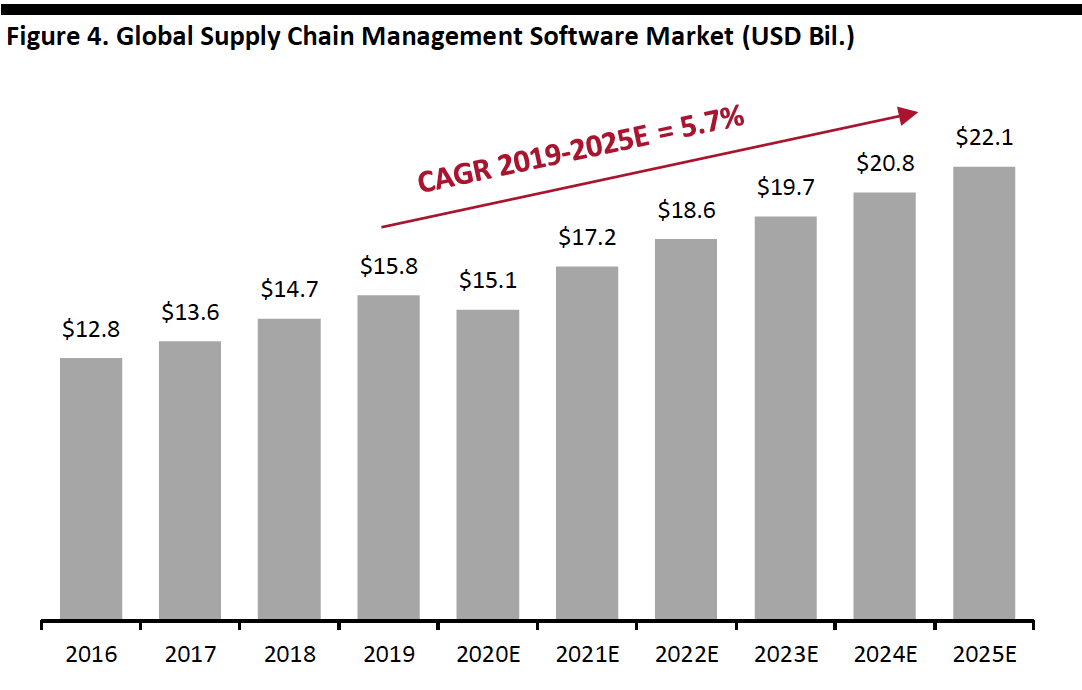
albert Chan
What’s the Story?
Supply chain software was already becoming an essential tool to manage complex, data-fueled retail prior to the Covid-19 outbreak. The steady encroachment of data-savvy e-commerce companies, consumers armed with data on pricing and features from the Internet, and rapidly increasing consumer demand and changing preferences, mean that traditional retailing is no longer adequate.
Even for retailers that have embraced technology, the outbreak strained supply chains, which were previously tuned to maximizing margins amid steady demand. The disruption highlighted the areas lacking flexibility, requiring management intervention to pivot to e-commerce while stores were closed. The pandemic has thus underscored the need for retailers to have flexible, adaptable supply chains.
As part of our RetailTech series, this report discusses the functionality of the modern supply chain, its components and the leading global companies that provide software tools for supply chain management.
This report builds upon our prior report from 2019, RetailTech: Supply Chain Software.
Why It Matters
The supply chain represents the circulatory system of a retailer, from sourcing to distribution, and feeds information about demand and consumer purchasing patterns back into the organization to guide future orders from the factory.
Product shortages during the Covid-19 outbreak revealed a non-resilient supply chain that was tuned for ordinary demand patterns and was not flexible enough to handle surges in demand for certain items. This inflexibility resulted in the following consequences for retailers and consumers:
- Lost sales due to a lack of availability of key items
- Reduced customer satisfaction due to a lack of product availability
- Volatility due to periods of stocking up
- Higher prices due to the lack of supply chain elasticity
Supply chain software can help retailers prepare for future demand shocks and manage their business more efficiently.
Segment Outlook
Wide swings in regional demand due to the spread and resurgence of Covid-19 are likely to persist for some time, perhaps for an extended period. Brick-and-mortar/multichannel retailers’ need for robust tools like supply chain software is likely to intensify in the future due to greater competition on many fronts:
- Intensified competition with e-commerce retailers, which have gained significant share during the pandemic as more consumers were driven to, and have become more comfortable with, shopping online
- Heightened competition with other multichannel retailers, which have digitalized and have adopted automated and advanced analysis tools and processes
- Other platforms such as multi-enterprise platforms that enable suppliers, buyers and sellers to collaborate and communicate efficiently
- Competition from international retailers, many leveraging advanced computing technology, as shopping becomes more global
There are numerous benefits to retailers in adopting a robust, automated solution, including greater efficiency, higher profitability, reduced loss and waste, and the ability to reduce environmental impacts and manage sustainability.
Supply Chain Software 2020: A Deep Dive
This section differentiates modern, bidirectional supply chains from the one-way chains of the past and discusses the technologies they use and what they do.
Shaking Off the Supply Chain of the Past
Previously, supply chains merely focused on sourcing the product to delivering it to the warehouse, the store and ultimately the consumer, in a single direction with little information flow and linkage between the functions, as shown in Figure 1.
[caption id="attachment_119815" align="aligncenter" width="700"] Source: Coresight Research[/caption]
Source: Coresight Research[/caption]
As competition has intensified due to advancing IT-powered e-commerce and technology tools, this linear supply chain is no longer competitive. In the meantime, retailers and their suppliers have embraced the power and benefits of a multidirectional supply chain. Today’s supply chains do not flow in a unidirectional line; rather, the functions are interconnected, and information flows from the customer to manufacturing and everywhere in between.
Figure 2 depicts a modern, technology-powered supply chain, which includes the traditional elements but with product flowing in one direction and information flowing in the opposite direction, supported by a platform of enabling technologies.
[caption id="attachment_119816" align="aligncenter" width="700"] Source: Coresight Research[/caption]
Source: Coresight Research[/caption]
Beyond the above diagram, functions within a retailer are highly interconnected. For example, the output of the demand planning function has implications for pricing, inventory, assortment, discounting and ultimately, consumer demand, which influences the next product cycle.
Technology
The functionality and efficiency of supply chain platforms benefit from the following technologies:
- AR/VR (Immersive Technologies)—Augmented and virtual reality (AR and VR) can enable retailers to visually manage their supply chains and stores.
- AI/ML—Software that integrates AI and ML can optimize forecasts and processes and identify patterns that humans cannot see. Given the large data sets and complexity of many retailers’ assortments (for example, a grocer can have 15,000–60,000 SKUs), this technology is becoming ubiquitous.
- Autonomous vehicles/drones—Drones have applications inside warehouses and in the last mile for residential delivery, particularly for difficult-to-reach places.
- Blockchain—This technology offers an indelible record of transactions and data, finding applications in the authenticity and cold chain of food items.
- Cloud computing—Retailers can reduce the fixed expense of IT hardware and teams and benefit from more frequently updated platforms with the ability to rapidly create leading-edge cloud applications.
- Internet of Things—IoT technologies enable retailers to connect and share data among a large number of devices, for applications such as tracking vehicles and other high-value items.
- Robotics—Applications of robotics inside the store, warehouse and in huma-robot teams include vehicle unloading, fulfillment and delivery.
Supply Chain Software Functionality
The functionality of the supply chain expends beyond its name, since supply chains dominate a retailer’s business activity: They receive inputs from and influence many of the other functions within a retailer’s ecosystem.
There are three main areas in which supply chain software can be applied: planning, logistics and operations. We discuss each of these below.
[caption id="attachment_119817" align="aligncenter" width="550"] Source: Coresight Research[/caption]
Source: Coresight Research[/caption]
Planning
Planning decisions have enormous consequences for practically all functions of a retailer, affecting sales, margins and working capital. For instance, demand forecasting drives production, which has implications for assortment, inventory and pricing. If demand is misjudged, then an oversupply of product could cause inventory imbalances and force the retailer to offer a promotion or slash prices, which could hurt revenues and margins.
Planning includes the following functions:
- Assortment optimization—Assortment is influenced by consumer trends and inventory forecasts.
- Demand forecasting—Demand is based on historical trends, current trends and external data.
- Inventory optimization—Inventory needs to be in the right location in the right quantity at the right time.
- Replenishment—Restocking is similar to initial stocking and must be timely in order to avoid missing out on sales opportunities.
- Supply planning—Manufacturing orders are a function of existing inventory and forecasted demand.
Logistics
Beyond the standard function of getting goods from to the factory to the warehouse and from the warehouse to the store, other functions include getting the right product in the right store, as well as optimizing warehouse layouts and scheduling workers.
Logistics includes the following functions:
- Allocation—Based on expected demand, inventory needs to be sent to the right warehouse and the right store.
- Track and trace—Retailers need to know the location of inventory in transit and in the warehouse for optimal allocation.
- Transportation—Similar to above, supply chain systems need to track inventory and handle emerging issues while in transit.
- Warehouse management—Inventory can be placed optimally within the warehouse for flexibility and speed.
- Workforce management—Staff must be allocated to handle anticipated demand in the right location.
Retail Operations
The above definition of the supply chain includes the physical store and the pricing, merchandising, promotions and positioning/physical location of product. Such functions have implications for inventory, production and logistics in the subsequent product cycle.
Operations include the following functions:
- Finance—Managing payments and finance is an increasingly important part of supply chain management.
- Merchandising—Campaigns can drum up demand and affect inventory and replenishment.
- Pricing—Pricing affects sales, demand, inventory and replenishment.
- Promotions—Promotions affect sales and inventory.
- Store layout—The location of product within the store can affect demand, inventory and replenishment.
Other Functions: Sustainability
Sustainability concerns permeate the supply chain, since resources are consumed and waste is generated throughout production, logistics, transportation and consumption. Resources, waste disposal and environmental cleanup cost money. Sustainability represents one input variable in supply chain optimization.
SAP demonstrated a partnership with auto maker Porsche that allowed a car buyer to understand the carbon impact of various choices and options of the purchase process and select the desired impact on the vehicle’s production and delivery, which brings corresponding changes to the automatable supply chain.
Industry Themes
The dramatic shifts in consumer demand in 2020 have shifted the focus onto several themes in supply chain software:
- AI/ML—Adding AI and ML enables algorithms to run around the clock, constantly looking to find relationships among data and for ways to improve forecasting accuracy.
- Agility—Supply chains need to be able to handle volatility, including unanticipated changes in demand.
- Alternative data—Bringing in alternative data sources such weather, the day of the week and local events dramatically improves the accuracy of demand forecasting.
- Cloud computing—Moving to the cloud enables retailers to benefit from the advantage of cloud software, including scale, frequent updates and accelerated innovation.
- Resilience—Supply chains need to be able to return to their pervious, normal state following unexpected shifts in demand.
- Security—Retailers and consumers need to be assured that their data is well-protected from hackers and competitors.
- Speed—Supply chains need to be able to adapt to changes in demand in a timely fashion, before consumers switch to competitors.
- Visibility—More than ever, retailers need data on where product is and to be able to communicate with the links in the supply chain.
Global Supply Chain Software Market
The global supply chain market is estimated at $15.1 billion in 2020 and is expected to grow at a 5.7% CAGR during 2019–2025E, according to Statista (albeit impacted by Covid-19 in 2020, as shown in Figure 4).
[caption id="attachment_119818" align="aligncenter" width="550"] Note: Forecast adjusted for expected impact of Covid-19, August 2020
Note: Forecast adjusted for expected impact of Covid-19, August 2020Source: Statista[/caption]
Supply Chain Software Vendors
There is a broad and diverse group of companies offering supply chain software, which we classify into three major categories: global software and ERP vendors, independent ERP and supply chain software vendors, and innovators.
Global Software and ERP Vendors
This category includes global vendors of ERP software including Oracle and SAP, in addition to cloud-software and infrastructure providers such as IBM. ERP software has expanded beyond its origins in manufacturing to include other functions such as finance, CRM (customer relationship management) and other supply chain functions.
Figure 5. Profiles of Selected Global and ERP Software Vendors
[wpdatatable id=570]Source: Company reports
Independent ERP and Supply Chain Software Vendors
These companies have developed their own free-standing ERP or supply chain software solutions, without being built on a preexisting platform.
Figure 6. Independent ERP and Supply Chain Software Vendors [wpdatatable id=571]
Source: Company reports
Innovator Supply Chain Software Vendors
There are several innovators offering various types of supply chain software, and several included in Figure 7 focus on transportation and the last mile.
Figure 7. Profiles of Innovator Supply Chain Software Vendors [wpdatatable id=572]
Source: Company reports
What We Think
The repercussions from the pandemic have revealed weaknesses in retailers’ supply chains and highlighted that resilient, agile supply chains are essential. The complexity of supply chains—particularly in grocery—extends beyond the human ability to manage, and technology such as ML can locate unseen areas of improvement. Moreover, software featuring AI can run continuously, steadily improving over time. At the same time, cloud computing has also become essential for retailers, offering unique opportunities to take innovation to a higher level.
Implications for Brands/Retailers
- Brands can make use of software to manage their own supply chains more efficiently and integrate with retailers’ supply chain platforms.
- Retailers can leverage a two-way supply chain to make their business more profitable and efficient by integrating demand data into manufacturing orders.
Implications for Real Estate Firms
- Retailers’ operating supply chains more efficiently should reduce demand for warehouse and fulfillment center space.
Implications for Technology Vendors
- Digitalization and the move to the cloud offers opportunities for software vendors to help retailers take advantage of leading-edge tools and platforms.
- The diversity in types of brands and retailers offers many opportunities for software vendors of all sizes, including targeted or niche players.
- AI/ML have become fundamental technologies that have been built into major cloud, ERP and supply chain software platforms.
Further Coresight Research Reports
RetailTech: Demand-Forecasting Software
Coresight Matrix: Supply-Chain Analytics Software